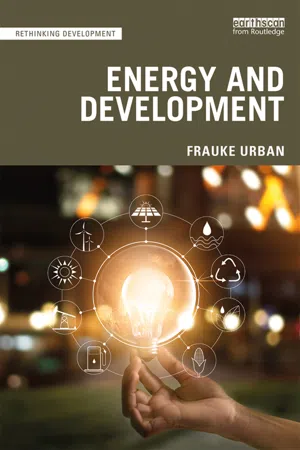Geography
Domestic Energy
Domestic energy refers to the energy consumed by households for heating, lighting, cooking, and other domestic activities. It is a significant contributor to global energy consumption and carbon emissions. The sources of domestic energy vary by region and include electricity, natural gas, oil, coal, and renewable sources such as solar and wind power.
Written by Perlego with AI-assistance
Related key terms
Related key terms
1 of 4
Related key terms
1 of 3
3 Key excerpts on "Domestic Energy"
- eBook - ePub
Surviving and Thriving on the Land
How to Use Your Spare Time and Energy to Run a Successful Smallholding
- Rebecca Laughton(Author)
- 2008(Publication Date)
- Green Books(Publisher)
Chapter Seven Domestic EnergyA smallholder’s domestic and working lives are usually inextricably intertwined, and it is almost impossible to isolate one from the other. To remain healthy and have enough energy to work effectively, it is important to have a warm, dry and comfortable home in which to relax, prepare and eat meals, sleep, look after children and do paperwork. Furthermore, where renewable energy is being used for heating, cooking and light, an efficient system is required, to prevent large amounts of time being absorbed by firewood management or maintenance of off-grid electrical equipment. This may sound obvious, but I have encountered situations where cramped, damp, cold or dark accommodation is having a negative impact on the health and ability of inhabitants to carry out their business. Whilst inadequate housing may be a necessary temporary measure, while more permanent accommodation is built or planning permission sought, a well-designed, warm and comfortable home is a vital ingredient for the long-term sustenance of human energy.House designI was inspired by some beautifully designed homes, which were easy to heat with renewable resources and provided spaces conducive to both work and relaxation. This section draws on such examples and describes key building design principles which can affect human energy.When the energy of the people who are to live in the house is considered, the efficiency of fuel use for heating and the choice of fuel for cooking are of tantamount importance. An ecological home should be easy to heat and exploit natural light. The principles enlarged upon below, provide a useful check-list in designing accommodation for a person or family who will be living in a low-impact way on the land: - eBook - ePub
Energy and Society
A Critical Perspective
- Gavin Bridge, Stewart Barr, Stefan Bouzarovski, Michael Bradshaw, Ed Brown, Harriet Bulkeley, Gordon Walker(Authors)
- 2018(Publication Date)
- Routledge(Publisher)
Figure 1.2 ), deploying it to transform the environment and accumulate economic and social infrastructure. The amount of energy under human control has increased enormously: Grubler (2004) estimates that global energy use in 1800 stood at around 20 exajoules, increased to 50 exajoules by 1900 and by 2010 was around 500 exajoules. In short, global energy use has risen twentyfold in 200 years, while the population has increased sevenfold (Smil 2010). The result is that energy has become much more abundant over time, as measured by both the quantity available per capita and the time/energy that must be expended to acquire it. Large portions of the population have become accustomed to living in a high-energy society, while this is also an aspiration for most people who do not yet have it. However, the small fraction of the Earth’s energy resources that can be captured, harnessed and transformed is unevenly distributed in fundamental ways. High-quality energy resources do not occur everywhere and access to resources and key technologies of energy capture and transformation is structured by prevailing distributions of wealth and power. Similarly, the social and environmental acceptability of energy resource landscapes also demonstrates social and spatial variation, as does the environmental and social consequences of energy production and transportation.Figure 1.2 Energy availability over time (based on GEA 2013)The search for socially valuable energy resources has diversified humanity’s portfolio of primary and secondary energy sources over time (Figure 1.2 ). Simultaneously, however, a small group of primary and secondary sources have become dominant in the global energy mix. First, three hydrocarbon energy resources – oil, coal and gas – account for over 85% of all primary energy consumed worldwide. During the twentieth century, coal, oil and gas came to account for an ever-larger proportion of total energy supply. This growing role of fossil fuels in the global energy mix reflected some spatial diffusion of energy demand, but was principally a result of the enormous command over fossil energy resources enjoyed by a relatively small group of industrial countries. Towards the end of the century, however, investments in hydropower and nuclear electricity, together with the roll out of renewables, began to make a dent in the domination of fossil energy resources (Figure 1.2 ). Energy from these resources has doubled in the last 25 years, rising from around 10% to over 15% of the primary energy produced worldwide: hydro-electricity, nuclear power and renewables account for 6.7%, 4.4% and 2.7% respectively. Second, a growing proportion of primary energy has been converted to secondary energy sources of electricity and liquid fuels prior to final consumption. Electricity consumption has grown fourfold in the last forty years and, in that time, it has increased from 9% to 18% of final energy consumption (IEA 2016). As a consequence, modern civilisation depends to a remarkable degree on the appropriation of subterranean energy resources from a relatively small proportion of the Earth’s surface, and their transformation and subsequent distribution as liquid fuels and electricity: in short, the experience of daily life for most people in the high-energy societies of the global North, and for a large and growing proportion of those in the emerging economies of the global South, rests on energy resource landscapes of oil and gas fields, coal mines, oil refineries and thermal power stations (see Example - eBook - ePub
- Frauke Urban(Author)
- 2019(Publication Date)
- Routledge(Publisher)
2 Energy use and energy systems in different countries and contexts Energy and energy systems for development: key issues Key definitions Energy use refers to the consumption of energy. For example, energy can be used by households or industries, for a wide range of purposes and end-uses. Energy demand refers to the energy that is demanded or needed by customers. It involves the customer’s willingness and ability to pay or access a specific energy service or energy product. For example, demand for electricity is highest during peak times such as in the evenings when lighting is needed. Demand for fuelwood is high in many developing countries, particularly for cooking. Energy supply is defined as the delivery of a fuel for consumption. To achieve energy supply, several processes can be involved, such as energy extraction, generation, transmission, distribution and storage of fuels. For example, electricity is supplied to grid-connected customers. The term energy system refers to an interrelated network of energy sources, connected by transmission and distribution of that energy to where it is needed. An energy system encompasses the production, generation, transmission and use of energy, including its technology. For example, a grid-based energy system includes the sourcing of energy resources, the power stations or energy technology that generate the electricity, the transmission lines and converter stations that transmit the electricity as well as the end-uses that consume the energy. Energy carrier refers to a substance or system that contains potential energy that can be released and used as actual energy in the form of mechanical work or heat or to operate chemical and physical processes. Energy carriers include batteries, coal, dammed water, electricity, hydrogen, natural gas, petrol and wood
Index pages curate the most relevant extracts from our library of academic textbooks. They’ve been created using an in-house natural language model (NLM), each adding context and meaning to key research topics.
Explore more topic indexes
Explore more topic indexes
1 of 6
Explore more topic indexes
1 of 4


